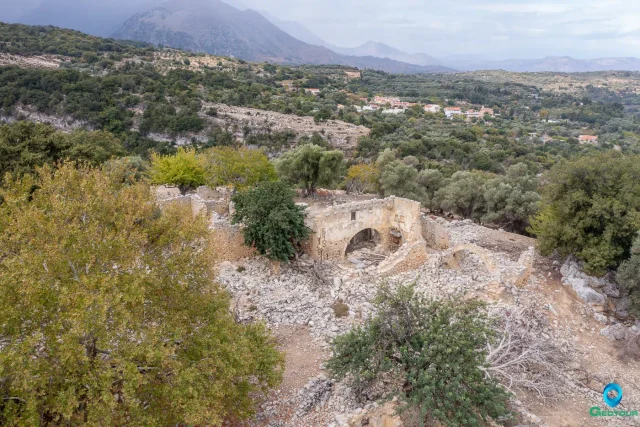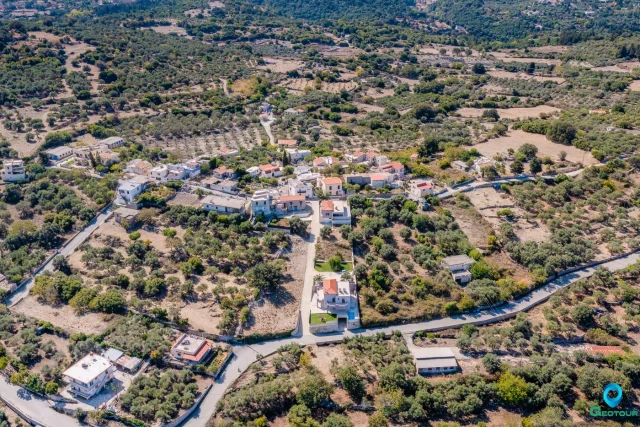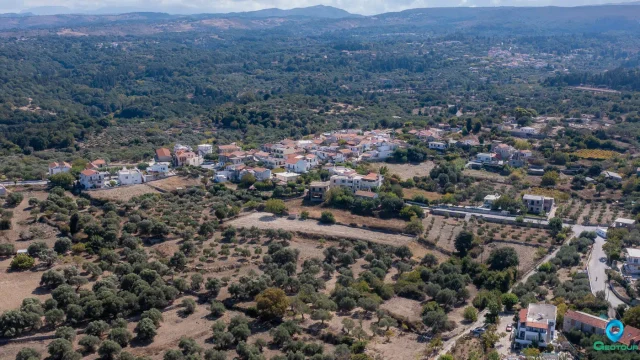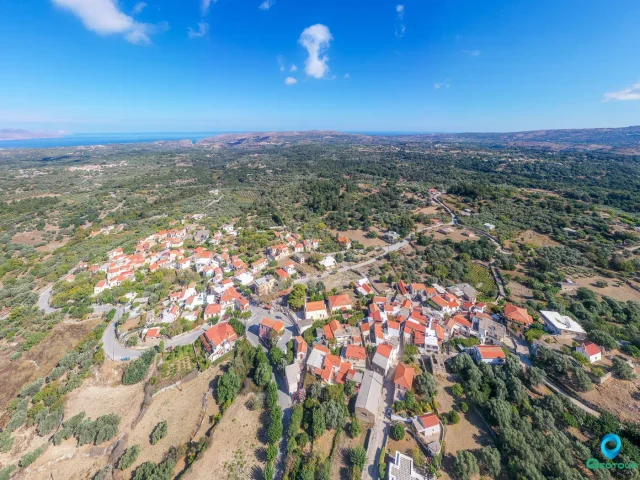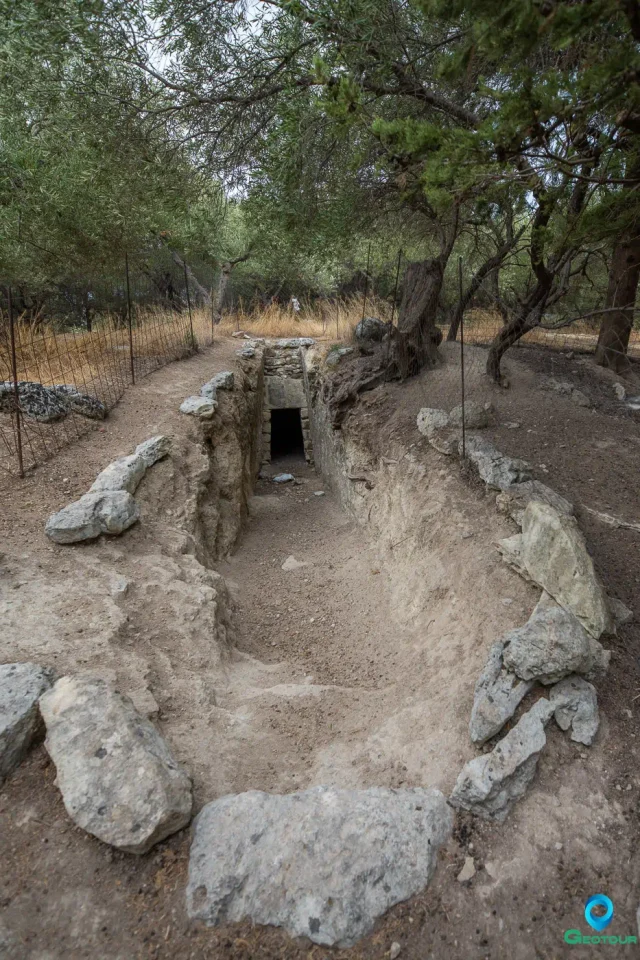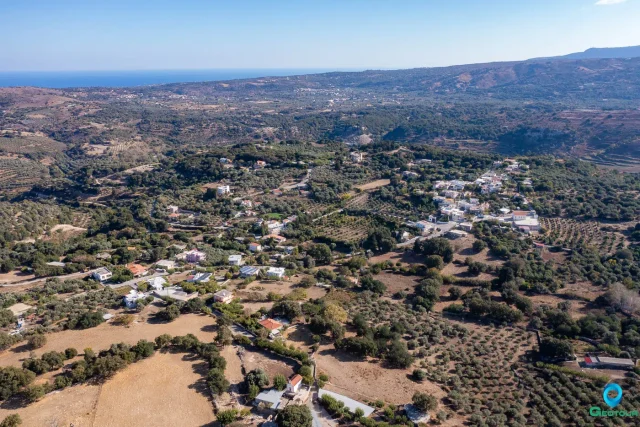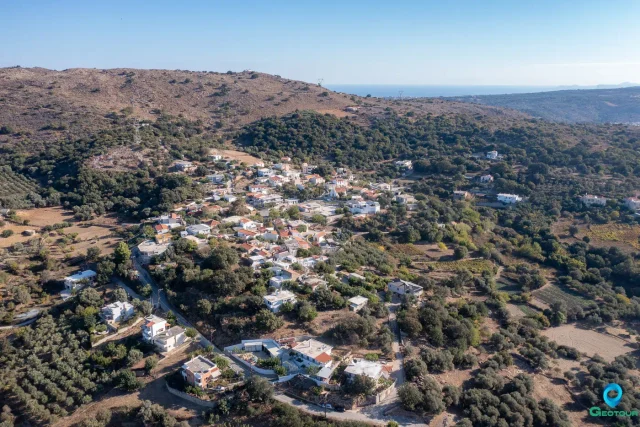The ancient city of Lappa is located beneath the modern village of Argyroupoli in the Rethymno prefecture, requires bringing together evidence from various archaeological investigations and textual sources. It was strategically positioned atop a hill between the Petres and Mousselas rivers, offering command over both river valleys and a view stretching towards the territory of Aptera. This location provided access to crucial east-west and north-south transit corridors across the island.
Historical Periods
The archaeological record indicates that Lappa has a long history of occupation. Evidence for the Geometric period, including pottery, has been found, suggesting the site was an important settlement even in the Early Iron Age, a significance it would maintain through later periods. The Hellenistic period saw the city’s continued development, with architectural traces like fortification walls identified. Finds from this era include imported goods such as stamped amphora handles and relief-decorated skyphoi, highlighting its commercial activity.
The Roman period marked a significant phase for Lappa. Under Augustus (or Octavian), the city gained the status of a civitas libera, or free city, a privileged position akin to a colony, making it exempt from direct provincial governor oversight. This status, along with rebuilding and repopulation efforts, was a reward for its Julian loyalties and aimed to restore an area damaged by military activity, realign communications, and settle Italian populations, possibly including Antonian supporters or veterans. This Augustan attention is corroborated by inscriptions honoring Augustus and Agrippa, the latter as a patron between 18 and 12 BCE. The presence of Roman names in inscriptions from the 1st century BCE onwards further points to the identity of some of these settlers. The city minted coins under Augustus or Tiberius, and later provincial coinage under Tiberius and Domitian. Archaeological finds like Italian and Campanian sigillata are linked to the arrival of Italian settlers and the city’s integration into the Roman world.
Activity appears strong through the High Imperial Period, supported by widespread archaeological evidence. However, evidence for Lappa becomes scarcer or non-existent after the mid-2nd century CE. This aligns with a broader trend observed in some inland towns in Crete and other eastern Mediterranean regions, potentially linked to the economic crisis of the 3rd century CE, which affected long-distance trade and led to regionalization.
Following the Roman period, Lappa was destroyed by the Arabs in 828 CE, and its ancient name was forgotten for a time. Architectural remains from Byzantine times have also been noted in excavations.
Key Historical Events
Several specific events shaped Lappa’s history. The period between the Knossos-Lyttos war of 221/20 BCE and the Metellan conquest saw a time of relative security and prosperity. The Metellan conquest of Crete (second-first century BCE) involved a siege of Lappa, and destruction layers found in archaeological contexts, with evidence of burning in plots like Lefou, Vougioukalakis, and Manolopoulos, may represent the physical impact of this event. Following the conquest, the actions of Augustus transformed the city, granting it free status, facilitating its rebuilding, and orchestrating its repopulation with Italian settlers. The patronage of Agrippa, evidenced by an inscription, further highlights the city’s importance within the Roman imperial program.
Archaeological Investigation
Archaeological knowledge of Lappa is largely derived from numerous systematic rescue excavations undertaken since the 1980s, particularly in the period between 1986 and 1990, often in response to construction activities in the modern village of Argyroupoli. Trial excavations, such as the one in the Lefou plot in 1969, were also conducted to control areas damaged by agriculture and irregular digging. These rescue excavations and trials contrast with the systematic investigations seen at other sites like Eleutherna.
Key plots yielding significant information include the Lefou, Vougioukalakis, and Manolopoulos plots, located in the center of the ancient city. A Roman necropolis serving the Hellenistic-Roman city was excavated at Pente Parthenes east of the city. Surface surveys, like the one conducted in 2000-2001 as part of an inventory program, have also contributed to understanding the site within the broader modern Demos of Lappa. The spatial distribution of finds across different plots seems to reflect this history of archaeology rather than solely ancient patterns.
Archaeological Discoveries: Architectural Remains and Sites
Despite the focus on rescue archaeology, significant architectural remains have been uncovered. Traces of Hellenistic fortification walls have been identified. Domestic architecture has been explored, notably in the Vougioukalakis plot, which revealed remains of a domestic unit with distinct chronological phases. The Manolopoulos plot also contained structures from late Hellenistic and Roman periods. While not systematically excavated, the Lefou plot revealed parts of a Roman building complex, apparently a bath, with a drainage system, pavement, walls, and stairs.
Public buildings are also attested. The Manolopoulos plot was on the northern side of the ancient Agora, suggesting its location. Evidence for multiple bath complexes exists within the ancient city, with potential sites noted in the Kiagiadakis plot, near the springs (Gerola’s bath), near Ag. Kyriaki, and possibly at Philias. The bath in the Lefou plot is described as part of a Roman building complex. A Roman water cistern on the south side of the lower city, documented by Pashley, has been restored and still provides water to the modern village. While reports mentioned an aqueduct, only a lead water pipe has been found as evidence of a Roman water delivery system. Rescue excavations have also identified the Roman necropolis at Pente Parthenes.
Beyond the urban center, Lappa controlled harbors on the north coast (Hydramia, Amphimalla) and communicated with southern harbors around Plaka bay in the Ag. Vasileios valley (Phoenix Lappaion, Lamon, Apollonia) via the Kotsiphou gorge. Spratt noted Plakias as a small summer anchorage in this area.
Religious sites are less directly evidenced through architecture in the main excavated plots, although an Aphrodite Genetrix statue was found in one room of the Roman building complex in the Lefou plot, with the head found in a nearby well. The Diktynnaion is mentioned in the context of Roman names attested there and also at Lappa.
Archaeological Discoveries: Material Culture
The excavations, particularly at the Lefou, Vougioukalakis, and Manolopoulos plots, have yielded a rich collection of inscribed instrumenta domestica, ranging from the mid-late fourth century BCE to the early Roman period. This category includes various types of objects such as pottery, amphora handles, loomweights, tiles, metal objects, a sling bullet, a lamp, a lead water pipe, and an incised gem.
Specific pottery classes found shed light on local practices and external connections. Relief-decorated skyphoi, found in large numbers (236 sherds) in the Vougioukalakis plot, provide information on Hellenistic socio-economic conditions and commercial relationships. Imported fine wares like Attic echinus bowls (one from Lefou, another from Vougioukalakis) indicate contact with Attica from earlier periods. Megarian skyphoi were found in the earlier phase of the domestic unit in the Vougioukalakis plot.
A significant portion of the material culture consists of terrae sigillatae, imported from various production centers including Italy (specifically Campania), the Greek East (Eastern Sigillata B), and possibly Asia Minor (Candarli or Eastern Sigillata C). Italian sigillata stamps, in particular, have been found across the Vougioukalakis, Lefou, and Manolopoulos plots. Stamped amphora handles, dating from the late Hellenistic to Roman periods, reveal import origins, including Rhodes, Knidos, and Kos, among others. Local pottery production in Argyroupoli is also attested, including amphorae, cups, tiles, loomweights, and other vessels, some bearing numbers or abbreviations. Comparisons of local Geometric pottery show similarities with finds from Eleutherna, Knossos, and Eltyna.
Coins found at Lappa include issues from Knossos (40/30 BCE) and Lappa itself (30 BCE), found in the Vougioukalakis plot, along with later coins from the 2nd and 3rd centuries AD. The city’s own coinage spans various periods from the 4th century BCE into the Roman imperial period.
Sculpture, such as the Aphrodite Genetrix statue from the Lefou plot, and mentions of imperial statues elsewhere in Crete, indicate the use of statuary in public or semi-public contexts.
Cultural and Economic Context
Lappa’s strategic location fostered extensive commercial connections and integrated it into complex trade networks, evolving from the Hellenistic to the Roman period. In the Hellenistic period, evidence like imported amphora handles and skyphoi points to relationships with trade centers across the Aegean. Under Roman rule, Lappa became actively engaged in transit trade and was well-connected to the Roman road network. The main Roman road linking western Crete to Gortyn passed through Lappa. Imports of Italian and Campanian sigillatae, as well as wares from the Greek East, illustrate its integration into the broader Mediterranean economy. The import of these fine wares and amphoras supplemented local production, demonstrating a desire for foreign goods. Lappa also had connections via north-south routes to its harbors on both the north and south coasts, facilitating maritime trade. Evidence suggests the potential export of goods, possibly including wine, as seen at other Cretan ports like Chersonesos.
Cultural practices reflect both local traditions and Romanization. The presence of baths is a strong indicator of Roman influence, representing a common architectural type introduced throughout the empire. The use of imported fine wares like sigillata for dining also points to changing social customs, possibly influenced by Italian settlers. Literacy is suggested by the presence of inscribed items like graffiti on pottery and stamps or abbreviations on local wares and imported amphorae. The onomastic evidence from inscriptions reveals Roman names among the population, offering insights into the identity and origins of the settlers, some of whom had connections to Campania and other parts of Crete.
Lappa’s civic status as a civitas libera under Roman rule was a defining political characteristic. This status influenced its relationship with the provincial administration and placed it within a different category than the colony at Knossos or the provincial capital at Gortyn. Imperial patronage, particularly that of Augustus and Agrippa, played a significant role in the city’s rebuilding and prosperity in the early Roman period. The reorganization of western Crete under Augustus, with Lappa at its center, was a strategic move affecting communication and trade patterns.
Connections within Crete and the Wider Mediterranean
Lappa occupied a notable position within the urban landscape of Roman Crete. It was situated in a strategically important zone between the free city of Kydonia to the west and the polity of Eleutherna to the east. The main Roman road connected it to these cities and extended eastwards through Sybritos towards Gortyn in the Mesara plain. North-south routes linked Lappa to its coastal harbors. The distribution of imported pottery like terrae sigillatae along this Roman road network is a key area of study for understanding regional connectivity. Lappa’s connections extended across Crete, evidenced by comparative pottery finds in the Geometric period and the presence of Roman names also found at Gortyn, Knossos, and the Diktynnaion in the Roman period.
Beyond the island, Lappa was integrated into the economic and political networks of the eastern Mediterranean and the Roman Empire. Trade links are shown through imports from Attica, Rhodes, Knidos, Kos, the Italian peninsula (including Campania), and Roman Asia Minor. The onomastic evidence suggests population links, particularly with Campania and the Italian peninsula. Crete as a whole, and Lappa specifically, were not isolated but functioned as a crossroads in the evolving Mediterranean world. While many Cretan cities, including Lappa, appear to thrive until the mid-2nd century AD, subsequent changes and potential decline reflect their entanglement in the broader economic shifts and crises affecting the empire.
Current State of the Site
Ancient Lappa lies directly beneath the modern village of Argyroupoli. Archaeological remains are integrated into the fabric of the modern settlement, with finds occurring during construction (rescue excavations). While systematic excavation is challenging, ongoing archaeological work by the Ephorate of Antiquities of Rethymno, including rescue excavations and surveys, continues to uncover and document the site’s history. Some structures, like the Roman cistern, have been restored and are still in use. The study of existing finds and continued excavation efforts offer the potential for a more complete picture of this important ancient city.
Key Points
- Location and Accessibility: Ancient Lappa is located beneath modern Argyroupoli in the Rethymno prefecture of Crete, situated between the Mouselas and Petres rivers, with access to both north and south coasts via river valleys and gorges. It was connected by the main Roman road running west-east across the island.
- Dimensions: Specific overall ancient city dimensions are not provided, but it was noted that Sybritos in the Roman period reached a maximum extent of c. 50-80 ha, while Eleutherna in the early Hellenistic period was estimated at 65-80 ha of domestic/public space, and Knossos decreased to c. 70 ha by the late 2nd century CE. No comparable figure is given for Lappa.
- Active Historical Periods: Occupation is attested from the Geometric period onwards, continuing through the Hellenistic, Roman, and Byzantine times, followed by destruction in the Arab period and subsequent habitation leading to the modern village.
- Historical Significance: As a civitas libera under Augustus, Lappa held a privileged status within Roman Crete and was a key point on the major Roman road network connecting western and central Crete. Its rebuilding and repopulation by Italians, potentially including Antonian supporters, following the Metellan conquest, highlight its importance in the Roman reorganization of the island.
- Current Status: The ancient city lies beneath the modern village of Argyroupoli, with remains largely discovered through rescue excavations prompted by modern construction. Archaeological work continues, integrating ancient remains with the modern landscape.
References
- Amanda Kelly, 2013. Roman Bathhouses on Crete as Indicators of Cultural Transition.
- Anastasia Tzigkounaki, 2019. The cities of Central-west Crete in historical times: Rithymna, Lappa, Eleutherna, Sybritos, Axos or Oaxos, in: Stampolidis, N.C., Tsangari, D.I., Giannopoulou, M. (Eds.), Cretan Cities: The Testimony of Coins. Alpha Bank, Athens.
- Angelos Chaniotis, 2013. Hadrian, Diktynna, the Cretan Koinon, and the roads of Crete A new milestone from Faneromeni (Crete), in: Eck, W., Fehér, B., Kovács, P. (Eds.), Studia Epigraphica in Memoriam Géza Alföldy, Antiquitas. Reihe 1, Abhandlungen Zur Alten Geschichte. R. Habelt, Bonn.
- Bowsky, M., 2007. From piracy to privileged status: Lappa (Crete) and the Romans. Presented at the XII Congressus Internationalis Epigraphiae Graecae et Latinae: Provinciae imperii romani inscriptionibus descriptae, 3-8 Septemper 2002, Barcelona, pp. 197–202.
- Bowsky W., M., Gavrilaki, E., 2010. FROM LAPPA Klios_Clay_Inscribed_Instrumenta_Domesti. Creta Antica 11, 173–252.
- Gavrilaki, E., Viglaki, P., Daskalakis, N., 2012. Skyphoi with relief decoration from Lappa (Argyroupoli) near Rethymno. Creta Antica 13, 227–300.
- Karambinis, M., 2022. The cities of Crete under Roman rule (1st–3rd centuries AD). JGA 7, 233–268. https://doi.org/10.32028/jga.v7i.1716
- Sampolidis, N., Giannopoulou, M., Baldwin Bowsky W., M. (Eds.), 2020. Klio’s clay II: more inscribed instrumenta domestica from Lappa (Crete), in: Eleutherna, Crete and the Outside World. Presented at the Eleutherna, Crete and the Outside World, Grecotel Creta Palace, Rethymno 31 May – 2 June 2018, pp. 411–420.
- Tzatzaki, N., 2018. On tlie footsteps of tJie geoιnetric settlement of Lappa (Argyropoιιli). Tlιe evidence of tlie pottery. Creta Antica 19, 301–322.
















